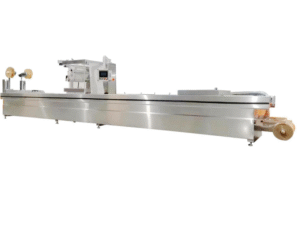Table of Contents
Introduction
In today’s fast-paced manufacturing and distribution industries, packaging machines play a crucial role in ensuring products reach consumers safely, efficiently, and in pristine condition. These automated systems have revolutionized the packaging process, offering speed, consistency, and cost-effectiveness that manual packaging simply cannot match. Understanding the different types of packaging machines available is essential for businesses looking to optimize their production lines and maintain competitive advantages in their respective markets.

Primary Types of Packaging Machines
The packaging industry encompasses a wide variety of machinery, each designed for specific applications and product types. The most common categories include filling machines, sealing machines, wrapping machines, labeling machines, and cartoning machines. Each type serves a distinct purpose in the packaging workflow, and many modern facilities employ multiple machines working in coordination to create complete packaging lines.
Filling machines are designed to accurately dispense products into containers, bags, or bottles. These machines range from simple gravity fillers to sophisticated volumetric and net weight fillers that ensure precise measurements for every package. Industries rely heavily on filling machines to maintain product consistency and reduce waste.
Sealing machines create airtight or secure closures on packages to protect contents from contamination, moisture, and tampering. Common sealing methods include heat sealing, induction sealing, and vacuum sealing. These machines are essential for preserving product quality and extending shelf life.
Food Packing Machine Categories
The food industry requires specialized packaging solutions that meet stringent hygiene standards and preserve product freshness. A food packing machine must comply with food safety regulations while efficiently handling various product types, from liquids and powders to solid foods and baked goods.
Vacuum packaging machines are popular food packing machine options that remove air from packages before sealing, significantly extending the shelf life of perishable items like meat, cheese, and prepared meals. These machines create an oxygen-free environment that inhibits bacterial growth and prevents oxidation.
Form-fill-seal machines represent another essential category of food packing machine technology. These versatile systems form packages from roll stock film, fill them with product, and seal them in a continuous operation. They’re commonly used for snack foods, coffee, frozen vegetables, and numerous other food products. The three main types include vertical form-fill-seal (VFFS) machines for products like chips and grains, horizontal form-fill-seal (HFFS) machines for items like candy bars and baked goods, and thermoforming machines for products requiring rigid packaging.
Tray sealing machines are specialized food packing machine equipment designed for ready-meals, fresh produce, and other food items that require attractive presentation. These machines place products in pre-formed trays and apply a sealed film lid, often using modified atmosphere packaging (MAP) to preserve freshness.
Flow wrapping machines, another type of food packing machine, create sealed packages around products using a continuous film. They’re ideal for individual portions of baked goods, confectionery, and fresh produce. The horizontal wrapping action creates professional-looking packages with excellent product protection.
Specialized Packaging Equipment
Beyond the standard categories, specialized packaging machines address unique industry requirements. Blister packaging machines create the familiar plastic-and-cardboard packages seen in pharmaceutical and consumer goods sectors. These machines form plastic cavities, insert products, and seal them to backing cards.
Shrink wrapping machines apply heat-shrinkable film around products or product groups, creating tight, protective packages. This method is popular for beverage multipacks, bundled products, and pallet stabilization. The versatility of shrink wrapping makes it suitable for items of various shapes and sizes.
Strapping and banding machines secure packages with plastic or metal straps, ensuring products remain intact during shipping and handling. These machines are essential for heavy or bulk items that require additional reinforcement beyond standard packaging materials.
Palletizing machines automate the stacking of packages onto pallets, organizing products in stable configurations for efficient storage and transportation. Robotic palletizers offer flexibility to handle multiple product types and package configurations with minimal changeover time.
Labeling machines apply product information, barcodes, and branding elements to packages. Modern labeling systems offer high-speed application with precise placement, supporting compliance with regulatory requirements and enhancing brand presentation.

Choosing the Right Packaging Machine
Selecting appropriate packaging machinery requires careful consideration of multiple factors. Production volume determines whether manual, semi-automatic, or fully automatic systems are most cost-effective. Product characteristics including size, shape, weight, and fragility influence machine selection and configuration.
Package type preferences—whether bags, boxes, bottles, or trays—dictate the categories of machinery needed. Budget considerations must balance initial investment against long-term operational costs, including maintenance, consumables, and labor requirements.
Integration capabilities are crucial for businesses planning to expand or modify their packaging lines. Machines should offer compatibility with existing equipment and flexibility for future upgrades. Regulatory compliance, particularly for food and pharmaceutical applications, must be verified to ensure machines meet industry standards.
Supplier reputation and after-sales support significantly impact long-term satisfaction with packaging equipment. Reliable technical support, spare parts availability, and training services help minimize downtime and maximize productivity.
Conclusion
The diversity of packaging machines available today reflects the complex needs of modern manufacturing and distribution. From basic sealing operations to sophisticated food packing machine systems with integrated quality control, these technologies enable businesses to package products efficiently while maintaining quality standards. Understanding the capabilities and applications of different machine types empowers companies to make informed decisions that enhance productivity, reduce costs, and meet customer expectations.
As packaging technology continues to evolve with advances in automation, sustainability, and smart manufacturing, staying informed about available options becomes increasingly important for competitive success.
Ready to upgrade your packaging line?We are a professional food packing machine manufacturer with extensive experience in delivering high-quality, reliable packaging solutions. Our team of experts can help you select the perfect equipment for your specific needs, ensuring optimal performance and return on investment. Contact us today to discuss your packaging requirements and discover how our innovative machines can transform your production efficiency.
